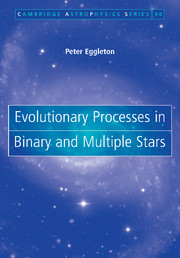Book contents
- Frontmatter
- Contents
- Preface
- 1 Introduction
- 2 Evolution of single stars
- 3 Binary interaction: conservative processes
- 4 Slow non-conservative processes
- 5 Rapid non-conservative processes
- 6 Accretion by the companion
- Appendix A The equations of stellar structure
- Appendix B Distortion and circulation in a non-spherical star
- Appendix C Perturbations to Keplerian orbits
- Appendix D Steady, axisymmetric magnetic winds
- Appendix E Stellar dynamos
- Appendix F Steady, axisymmetric, cool accretion discs
- References
- Subject index
- Stellar objects index
2 - Evolution of single stars
Published online by Cambridge University Press: 17 August 2009
- Frontmatter
- Contents
- Preface
- 1 Introduction
- 2 Evolution of single stars
- 3 Binary interaction: conservative processes
- 4 Slow non-conservative processes
- 5 Rapid non-conservative processes
- 6 Accretion by the companion
- Appendix A The equations of stellar structure
- Appendix B Distortion and circulation in a non-spherical star
- Appendix C Perturbations to Keplerian orbits
- Appendix D Steady, axisymmetric magnetic winds
- Appendix E Stellar dynamos
- Appendix F Steady, axisymmetric, cool accretion discs
- References
- Subject index
- Stellar objects index
Summary
Background
The evolution of single stars, and of those stars which are in binaries sufficiently wide that the effect of a companion can be ignored, has been much studied, especially with the aid of increasingly powerful computers over the last 50 years. This is not to say, however, that every problem has been solved: in the final section of this chapter I emphasise some of the outstanding problems.
Figure 2.1 shows a comparison between recently computed models, and data obtained by observation. They are shown in a Hertzsprung–Russell diagram (HRD) where luminosity, i.e. the total energy output of the star, is plotted against surface temperature; the latter is plotted backwards, for traditional reasons. Our theoretical understanding of the internal structure and evolution of single stars is based on the concepts of hydrostatic equilibrium, thermodynamic equilibrium and the consumption of nuclear fuel, mainly hydrogen. In hydrostatic equilibrium, the inward force of gravity is balanced by the outward push of a pressure gradient. In thermodynamic equilibrium, the heating or cooling of a spherical layer of material is determined by the balance of heat production in nuclear reactions, at temperatures of about 10MK(megakelvin) and upwards in the deep interior, against heat loss as heat flows down the considerable temperature gradient until it can be radiated into space from the photosphere at temperatures observed to be about 2–100 kK. The heat flux is carried either wholly by radiation, or by a combination of convection and radiation, depending on whether the temperature gradient that would be required to carry the heat entirely by radiation is less than or greater than the critical (i.e. adiabatic) temperature gradient at which convective instability sets in. Most stars contain some region or regions that are predominantly convective and some that are wholly radiative.
- Type
- Chapter
- Information
- Evolutionary Processes in Binary and Multiple Stars , pp. 31 - 108Publisher: Cambridge University PressPrint publication year: 2006

